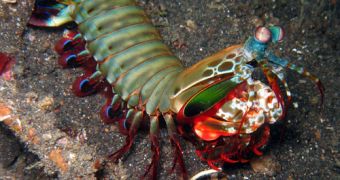There are various types of vision, from the one detecting visible light to the others detecting ultraviolet light and linear polarized light. A new research published in the journal "Current Biology" describes a fourth type of vision never seen before in any animal: mantis shrimps (Stomatopods), a type of sea crustaceans, detect circular polarized light. Stomatopods, which are not real shrimps, are characterized by their vivid colors and the specialized "boxing" fore pair of feet, which hit their prey with one of the fastest movements in the animal kingdom.
Circular polarized light is a spiraling beam spinning either to the left or to the right. Some animals, like scarab beetles, reflect circular polarized light, but this is the first time an animal is found to see this type of light. For this purpose, the Stomatopods developed a type of eye filter on a precise 45? angle to photoreceptors underneath, that transforms the circular polarized light into linear polarized light.
"Mantis shrimp ventured into a new dimension of vision. Many animals make use of linearly polarized light. To people, however, it is only glare, hence the need for polarized sun glasses," said co-author Justin Marshall of the University of Queensland in Australia.
The team described the anatomical features enabling the stomatopods to see circular polarized light and made behavioral tests on the crustaceans, showing they can be trained to associate either left-handed or right-handed circular polarized light (L-CPL or R-CPL) with food.
"Although it's not yet clear exactly what the mantis shrimps' newfound visual ability is good for in nature, it's likely all about sex. Stomatopods are known to use highly specialized color and linear polarization signals for complex social interactions," said Marshall.
The team detected 3 species of Odontodactylus stomatopods in which the cuticle of the males reflected CPL, but not that of the females. Moreover, those reflective zones were body parts connected to behavioral displays in stomatopods.
"We speculate that these CPL reflections could act as a secret communication channel. Linear polarization signals, used by marine invertebrates, are visible to animals like cephalopods that prey on stomatopods and are therefore open to exploitation. Also, other genera of stomatopods that we have examined have variable CPL sensitivity, and may be unable to view the sexual displays of Odontodactylus species, making this a private channel of communication, unavailable to both predators and potential stomatopod competitors. Humans use CPL filters and imaging in everyday photography, medical photography, and object-detection systems in turbid environments. The reefs and waters that many stomatopods inhabit are often turbid, and it is perhaps no surprise that, perhaps as long as 400 million years ago (when stomatopod crustaceans first appeared), nature got there first." - wrote the authors.

 14 DAY TRIAL //
14 DAY TRIAL //